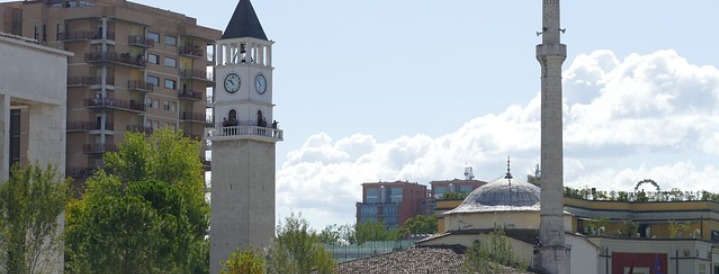A conglomeration of communist, Ottoman and Italian influences, the Albanian capital of Tirana is always evolving. Once dull and grey, the city has blossomed into a lively, colorful metropolis buzzing with a cosmopolitan vibe. Simply fascinating, Tirana represents both the past and the future of Albania.
Many of the city’s greatest highlights are located in the Porcelani district, so named because of its tile-making tradition. Some of the best shops, cafes and restaurants have recently sprung up around Ish-Blloku, the block of streets surrounding Ismail Qemali. Commoners were forbidden to enter the district during the communist era, but it was opened to the masses in 1991 and quickly became a hotspot for the city’s youth. During the day, expensive cars cruise around the wide boulevards, cafes open their terraces and serve up strong espressos, and trendy clothing items are on display in the many boutiques. At night, the streets are packed with locals celebrating the end of the workday at packed clubs, friendly bars, and luxurious lounges.
The area is also home to many of Tirana’s finest museums. At the National Archaeological Museum, visitors can walk through Albania’s ancient history by exploring well-curated exhibits highlighting Roman statues, Illyrian manuscripts and mosaics from the Hellenic times. More than a million books are on display at the National Library, including many ancient texts, and the Natural Sciences Museum gives a great introduction to the country’s geological composition and flora.
Enver Hoxha, the former dictator, called Ish Blloku home, and visitors can catch a glimpse of the proletarian life at his residence. The pastel-colored mansion remains as fascinating today as it was when it first opened in 1991.
Ish Blloku is the trendiest area of the capital, but Sheshi Skenderbej is its heart. The square is where locals go to gather, relax, socialize and protest. In 1991, an angry mob tore down the statue of Hoxha that once glimmered in the center, and today the only statue that remains is of Skanderbeg, a 15th-century lord, and the country’s most celebrated hero.
Albania is known around the world for the harmony that exists between its different religions. Although 70 percent of citizens are Muslim, the Eastern Orthodox and Roman Catholic faiths remain important parts of the country’s culture. The Et’hem Bey Mosque, built in the 18th century, is one of the most beautiful sights in Tirana. Its exquisite beauty actually saved it during the state’s atheism campaign, and today visitors can bask in the ornate painted dome outside of communal prayer hours. Unfortunately, many religious institutions were not spared from the government’s destructive path. The Orthodox Church of the Holy Evangelist was nearly annihilated during the campaign, and visitors today can still see the holes in the brickwork made by bulldozers.
The natural beauty of Albania is on full display at the Grand Park in the southern part of Tirana. Huge trees provide shade for picnics, open spaces are perfect for soccer games, and the mountains provide a stunning backdrop for an afternoon of relaxation. An artificial lake lies in the park’s center, and more than 120 varieties of plants thrive on the sprawling grounds.
Twenty-five kilometers east of the capital is Mt. Dajti National Park, where many Tiranans head on the weekends to find respite from the city rush. Take a gentle hike through the pine and beech forests, enjoy the views from the top of the mountain and breathe in the fresh air before indulging in a drink at one of the restaurants or cafes near the peak.
Tirana Geographical Location
Tirana is located in the western center of Albania on the Ishëm River. It is the largest city in Albania with a population of approximately 1,020,000 in the metropolitan area.
Tirana Language
Albanian is the official language of Albania.
Tirana Predominant Religion
- 70% Muslim
- 20% Albanian Orthodox
- 10% Catholic
Between 1967 and 1990 religious observances were prohibited.
Tirana Currency
The Albanian Lek is the official currency of Albania.
Tirana Climate
Tirana has a Mediterranean climate with hot summers and mild winters. The summers are relatively dry while the winters are quite wet.
Tirana Main Attractions
- Mount Dajti
- Skanderbeg Statue
- National History Museum
Other Attraction in Tirana
- Et’hem Bey Mosque
- Skanderbeg Square
- Grand Park
- Archeological Museum
